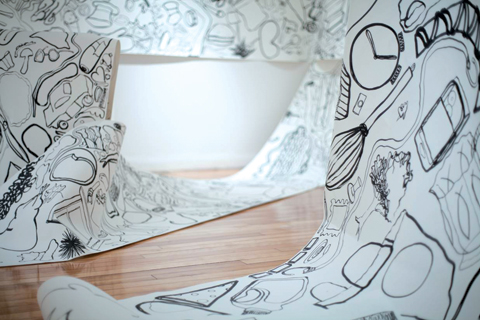
REPRESENTATION Making simple line drawings out of basic conceptual inputs. |
To consider "Everything," the new installation by artist Astrid Bowlby, consider what we know about the sausage maker.
But first, let's back up a bit — a few generations' worth — to the introduction of the engineering concept of the black box. Presently defined by Wikipedia as a "device, system, or object which can be viewed solely in terms of its input, output, and transfer characteristics without any knowledge of its internal workings," the black box was a useful way for industrialists to conceal the nasty, brutish, or confusing process by which something gets made.
Today, there are all sorts of black boxes — computers, credit analysis reports, Uzbeki sweatshops — but one of the most robust early examples was the sausage maker. In you place the mysterious miscellaneous offal, and presto, out comes a perfectly packaged sausage link.
The concept is useful in thinking about "Everything" — and Bowlby's work in particular — because though it may be the most uniquely labor-intensive show I've ever seen in Portland, it completely turns the black box on its head.
Bowlby, a distinguished artist and sculptor known mainly for her ink works of abstract and impenetrably dense black fields, is devoting the next six weeks to the task of producing a countless number of representational drawings within the USM gallery. Working in-residence from a small studio in the vestibule, she draws the images plainly, in black ink on large unfurled spools of white cotton paper, which she affixes in animated patterns throughout the gallery.
Not yet one week in, she has easily drawn over a thousand discrete images, all by hand. Objects, animals, artifacts — she applies them to paper in no discernible order. Not a hint of narrative; aesthetic detail bare minimum. Besides medium, and the fact that there are no second takes, their only criterion seems to be that they be representational. Indeed, anything that has a name, Bowlby will draw it. She has taped handwritten lists of hundreds of things (supplied by her students) to the walls of the studio, and placed a bowl for visitors' suggestions in the hall (I submitted Russian tortoise, parade float, and record stylus . . . fingers crossed!).
This is particularly significant for those familiar with Bowlby's past body of work, where, often, canvases or cut-paper accumulations of crawling, disarticulate lines would become collected into densely unified masses of blackness. They weren't violent; they were cold, machinic, and inscrutable, and their final form always seemed to amount to more than the sum of their parts. In other words, they both conceptually functioned and appeared to the eye like a black box. In "Everything," by stark, liberating contrast, the entire process is visible all the way through the production chain, making the radical, often impossible step of rendering the artistic process both noncommercial and completely transparent.